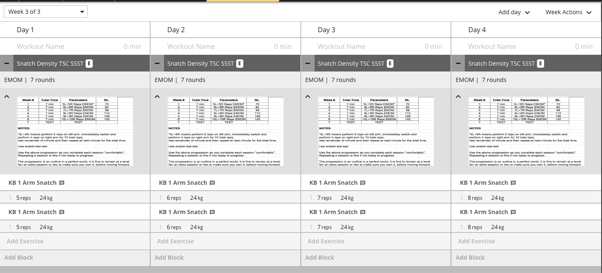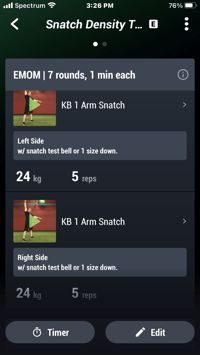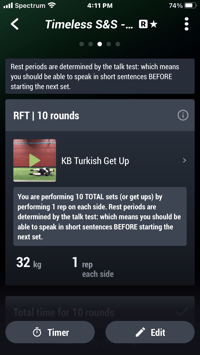[ad_1]
Programming specialized protocols that utilize kettlebells (or any other piece of equipment) can pose a significant challenge, especially when working with different digital platforms. By utilizing BridgeAthletic as your digital platform, you can tap into its immense power to effortlessly program these specialized protocols and, most importantly, make them more comprehensible for your athletes and clients.
Now, let’s take a closer look at a few examples of how these protocols appear from the perspective of both the programmer and the athlete.
Special Block Feature
To better understand, when you navigate to the “add block” option and select “new block“, you will be presented with the following choices: EMOM, RFT, and AMRAP.
Now, let’s delve into a few examples of how you can program these blocks for a specific protocol. This will not only ignite your creativity but also showcase the abundance of options available to you based on your programming preferences.

EMOM Blocks
The first protocol we will cover in this blog post is a time-based one known as the “Every Minute On the Minute” (EMOM) protocol. It’s worth noting that some people also refer to it as the “On the Minute” (OTM) protocol, but both terms essentially mean the same thing.
Let’s apply this as we program kettlebell snatches on the minute for 7 total minutes. On day 1, we will perform 5 reps on the left side and then 5 reps on the right side at the top of each minute.
EMOM x 7 minutes:
5 each arm of
Single Arm KB Snatches
We are going to program the progression plan as a “density” protocol meaning that the amount of work (the number of reps that we do each minute) that we do in a given amount of time is going to be progressively increasing while the total amount of time (7 minutes) stays constant.
At my gym, Results Fitness, we have often used this specific protocol as a peaking strategy to prepare for the Tactical Strength Challenge’s (TSC) 5-minute snatch test. It was inspired by the work of StrongFirst Certified Master Instructor, Jason Marshall’s article here.
Here is an example of what this EMOM progression would look like as the coach:


A notable feature to take note of is the ability to upload visual aids such as screenshots or PDF files. This feature proves to be incredibly valuable when providing precise and clear instructions to athletes. It is particularly useful for any programming that demands detailed explanations and the arrangement of progression plans.
Here is what that first day looks like from the mobile view which is going to be what your athlete or client sees:




The athlete will have no trouble understanding the instructions as they are clearly presented. The timing is synchronized with the protocol and accompanied by audible beeps every minute, making it a seamless experience.

RFT Blocks
Now, let’s dive into another example where we explore the application of the RFT protocol, also known as “Rounds for Time“.
This is what StrongFirst’s Director of Education Brett Jones refers to in his excellent book Iron Cardio, as a “work-constrained” protocol. This simply means that we have a pre-determined amount of work to doand we will track how long it will take us to perform this work. Ex: 10 total sets of 5 KB Swings + 5 KB Goblet Squats
Let’s now apply this using some “Simple and Sinister” (S&S) protocols. This is a program designed by StrongFirst’s founder Pavel Tsatsouline. It utilizes the KB single-arm swing and the KB get-up as the exercises of choice. You can learn more about the entire program and the rationale behind it here.
We will use rounds for time (RFT) to program the swings and get-ups in a “timeless” style. The protocol is to perform a set amount of work – 10 sets of 10 reps (sum total of both right and left sides) of the KB single-arm swing. You will complete 100 total reps and simply track the time that it takes to complete the work given the rest period guidelines. The get-up is a sum total of 10 sets of 1 rep (5 sets each side).
RFT: 10 Rounds
10 Single-Arm KB Swings (5/5)
RFT: 10 Rounds
10 KB Get-Ups (5/5)
Now, let’s take a glimpse of what the programmer’s perspective looks like on the desktop:

And what your athletes would see:




In this particular case, I opted to convey the rest period guidelines through notes instead of relying on visual aids such as PDF files or screenshots. Since the instructions were already clear and concise, there was no need for additional visuals to enhance the clarity.
One notable aspect is the ability to establish “benchmarks” (as seen in the times above) within these protocols, allowing for easy tracking of progress as time is recorded. This remarkable feature enhances the overall experience and ensures accurate assessment of improvement.
It is crucial for me to clarify that I am implementing a unique approach to programming the RFT protocol, deviating from the description provided in the information button (refer to the section below). This distinction must be communicated explicitly to the athlete, particularly regarding the specific rest parameters outlined in the notes.

AMRAP Blocks
In the third and final example, we will discuss the AMRAP “As Many Rounds/Reps As Possible” protocol.
In this particular strategy, we will be implementing a “time-limited” format, where we will set a timer for a specific duration (20 minutes) and monitor the productivity achieved within this timeframe.
Referenced earlier, here is an example of how to program a protocol from Brett Jones’ Iron Cardio book. This is performed by doing a pure combination or “chain” of a KB single-arm clean + single-arm press + single-arm front squat then rest and perform on the other side and rest again. Repeat this during the designated 20 minutes and track the total number of sets (sum total of both sides) completed during the time frame.
AMRAP x 20 minutes
Single-Arm KB Clean + Single-Arm KB Press + Single-Arm KB Front Squat
Here is the coaches POV:


And the athletes POV:


So there you have it – three practical examples of how to program and apply EMOM, RFT, and AMRAP protocols. I hope these examples have sparked your creativity and given you ideas on how to implement similar protocols within your organization.
When it comes to deciding which protocol to choose while programming, I like to think of EMOM, RFT, and AMRAP in the following way:
EMOM: Time and work constrained. This means that you have a fixed amount of work selected and a fixed amount of time allocated for it.
RFT: Work-constrained. With this protocol, you have a fixed amount of work selected, but the time it takes to complete it can vary.
AMRAP: Time-constrained. Here, you have a fixed amount of time selected, and the work completed within that time frame can vary.
These distinctions can help you make informed decisions when programming and ensure that you choose the right protocol for your specific needs.
Happy Programming!

Click here to get Pull-up Resolution discounted price while it’s still available…
[ad_2]


